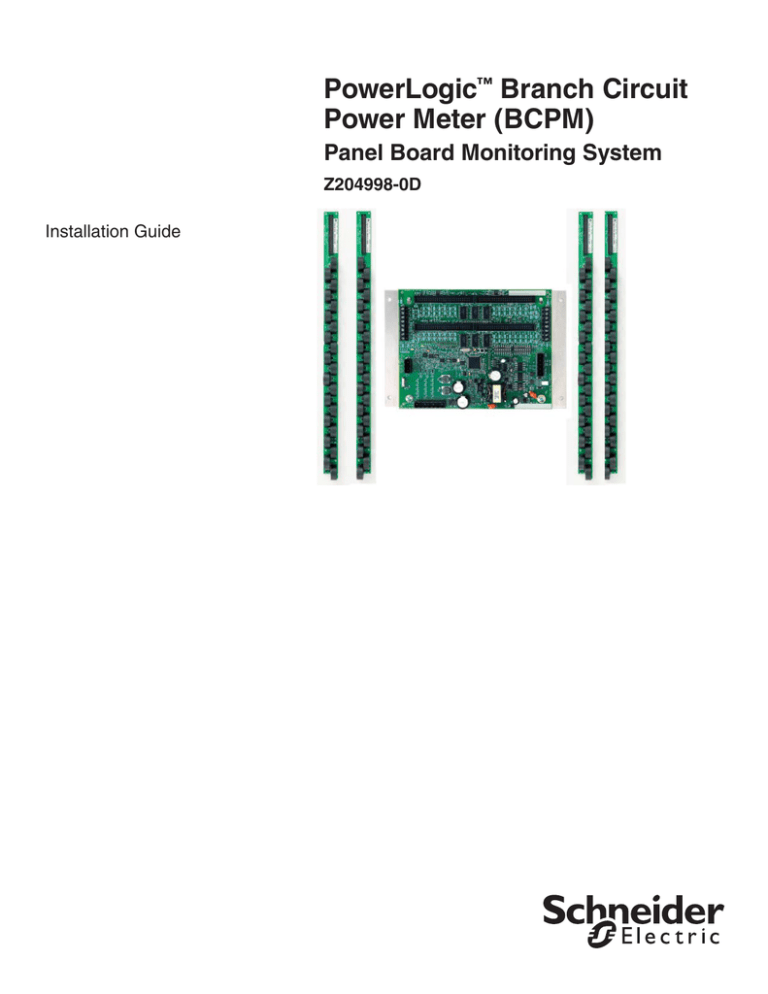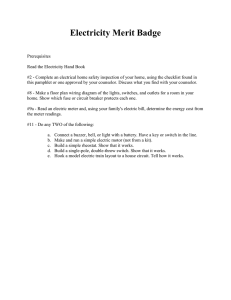
PowerLogic™ Branch Circuit
Power Meter (BCPM)
Panel Board Monitoring System
Z204998-0D
Installation Guide
Branch Circuit Power Meter (BCPM)
Z204998-0D
07/2008
HAZARD CATEGORIES AND
SPECIAL SYMBOLS
Read these instructions carefully and look at the equipment to become familiar
with the device before trying to install, operate, service or maintain it. The
following special messages may appear throughout this bulletin or on the
equipment to warn of potential hazards or to call attention to information that
clarifies or simplifies a procedure.
The addition of either symbol to a “Danger” or “Warning” safety label indicates
that an electrical hazard exists which will result in personal injury if the
instructions are not followed.
This is the safety alert symbol. It is used to alert you to potential personal injury
hazards. Obey all safety messages that follow this symbol to avoid possible
injury or death.
DANGER
DANGER indicates an imminently hazardous situation which, if not
avoided, will result in death or serious injury.
WARNING
WARNING indicates a potentially hazardous situation which, if not
avoided, can result in death or serious injury.
CAUTION
CAUTION indicates a potentially hazardous situation which, if not
avoided, can result in minor or moderate injury.
CAUTION
CAUTION, used without the safety alert symbol, indicates a potentially
hazardous situation which, if not avoided, can result in property
damage.
NOTE: Provides additional information to clarify or simplify a
procedure.
PLEASE NOTE
Electrical equipment should be installed, operated, serviced, and maintained
only by qualified personnel. No responsibility is assumed by Schneider Electric
for any consequences arising out of the use of this material.
FCC NOTICE
This equipment has been tested and found to comply with the limits for a
Class A digital device, pursuant to part 15 of the FCC Rules. These limits are
designed to provide reasonable protection against harmful interference when
the equipment is operated in a commercial environment. This equipment
generates, uses, and can radiate radio frequency energy and, if not installed
and used in accordance with the instruction manual, may cause harmful
interference to radio communications. Operation of this equipment in a
residential area is likely to cause harmful interference in which case the user
will be required to correct the interference at his own expense. This Class A
digital apparatus complies with Canadian ICES-003.
© 2008 Schneider Electric All Rights Reserved.
Z204998-0D
07/2008
Branch Circuit Power Meter (BCPM)
Installation Overview ........................................................................................... 1
Specifications...................................................................................................... 2
Introduction ......................................................................................................... 3
Parts of the BCPM.......................................................................................... 4
Dimensions..................................................................................................... 5
Data Output .................................................................................................... 6
Blink Codes .................................................................................................... 6
Installation........................................................................................................... 7
Wiring................................................................................................................ 11
Configuration .................................................................................................... 13
Communications Setup ..................................................................................... 15
Commissioning ................................................................................................. 16
Appendix A—ION Setup ................................................................................... 17
Basic Setup .................................................................................................. 17
Configuring Breaker Sizes ............................................................................ 19
Configuring CT Sizes ................................................................................... 20
Configuring Demand Setup .......................................................................... 21
Configuring Instantaneous Current Alarms .................................................. 22
Configuring Latching Current Alarms ........................................................... 23
Configuring Voltage Alarm Thresholds ......................................................... 24
© 2008 Schneider Electric All Rights Reserved.
i
Branch Circuit Power Meter (BCPM)
ii
Z204998-0D
07/2008
© 2008 Schneider Electric All Rights Reserved.
Branch Circuit Power Meter (BCPM)
Installation Overview
Z204998-0D
07/2008
DANGER
HAZARD OF ELECTRIC SHOCK, EXPLOSION, OR ARC FLASH
• Follow safe electrical work practices. See NFPA 70E in the USA, or
applicable local codes.
• This equipment must only be installed and serviced by qualified
electrical personnel.
• Read, understand, and follow the instructions before installing this
product.
• Turn off all power supplying equipment before working on or inside
the equipment.
• Use a properly rated voltage sensing device to confirm power is off.
DO NOT DEPEND ON THIS PRODUCT FOR VOLTAGE INDICATION
• Only install this product on insulated conductors.
Failure to follow these instructions will result in death or serious
injury.
NOTE: This product is not intended for life or safety applications. Do
not install this product in hazardous or classified locations. The installer
is responsible for conformance to all applicable codes.
INSTALLATION OVERVIEW
1. Turn off all power.
2. Mount current sensor strips adjacent to breaker terminations.
3. Verify that the serial numbers on the CTs match the serial numbers on the
printed circuit board (PCB).
4. Configure communication and addressing parameters using DIP switches.
5. Mount the main Data Acquisition Board in the electrical enclosure.
6. Connect current sensor strip cables to the main board, observing the 2-strip
or 4-strip setup.
7. Wire control power.
8. Wire voltage taps, if applicable (models BCPMA and BCPMB only).
9. Wire RS-485 communications.
10. Connect mains monitoring CTs to the auxiliary inputs on the PCB and
connect the CTs onto the mains conductors in the enclosure.
11. Commission the device for operation. See the “Commissioning” section later
in this guide for detailed instructions.
NOTE: For detailed instructions, please see the “Installation”
section later in this guide.
© 2008 Schneider Electric All Rights Reserved.
1
Branch Circuit Power Meter (BCPM)
Specifications
Z204998-0D
07/2008
SPECIFICATIONS
Table 1
Specifications
Type
Description
General
Control Power
90-277 Vac
Frequency
50/60 Hz
Sampling Frequency
2560 Hz
Update Rate
1.2 seconds per panel board
Overload Capability
10 kAIC
Ribbon Cable Support
Up to 20 ft.
Operating Temperature
Range
0° to 60°C (32° to 122°F)
(<95%RH, non-condensing)
Storage Temperature Range
-40° to 70°C (-40° to 158°F)
Accuracy
Current Monitoring
0.25 A to 100 A: 3% of reading from 0.25 A to 2 A; 2% of
reading from 2 A to100 A
Auxiliary Inputs
2% of reading from 1% to 10% of rated current; 1% of
reading from 10% to 100% of rated current
Voltage Input
90-277 Vac; 1% of reading from 90-277 L-N (models BCPMA
and BCPMB only)
Power
4% of reading from 0.25 A to 2 A; 3% of reading 2 A to 100 A*
(models BCPMA and BCPMB only)
Network Communications
Type
Modbus® RTU
Connection
DIP switch-selectable 2-wire or 4-wire, RS-485
Address
DIP switch-selectable address 1 to 247 (in pairs of 2)**
Baud Rate
DIP switch-selectable 9600, 19200, 38400
Parity
DIP switch-selectable NONE, ODD, EVEN
Communication Format
8-data-bits, 1-start-bit, 1-stop-bit
Termination
5-position depluggable connector
(TX+ TX- SHIELD TX+/RX+ TX-/RX-)
* Add 1% for 0.8 pf to 0.5 pf
** See Configuration section for details
UL listed under standard 508 as an “open type device.”
Installation category: CAT III
The BCPM Series must be installed in an appropriate electrical and fire enclosure
per local regulations.
For use in a Pollution Degree 2 or better environment only.
A Pollution Degree 2 environment must control conductive pollution and the
possibility of condensation or high humidity. Consideration must be given to the
enclosure, the correct use of ventilation, thermal properties of the equipment and
the relationship with the environment.
IEC/EN: EN 61010 CE
Always use this product in the manner specified or the protection provided by the
product may be impaired.
2
© 2008 Schneider Electric All Rights Reserved.
Branch Circuit Power Meter (BCPM)
Introduction
Z204998-0D
07/2008
INTRODUCTION
The PowerLogic® Branch Circuit Power Meter (BCPM) is a device designed
to measure the current, voltage, and energy consumption of up to 92 circuits
(84 branch circuits, plus 8 auxiliary circuits) on a single board. It increases the
board’s current monitoring capability by combining the functions of two boards
into one device.
The BCPM consists of a Data Acquisition Board and four 21-unit current sensor
strips and eight auxiliary inputs. The strips are mounted on each side of the
panel board along the termination points of each breaker. The conductor passes
through the appropriate current sensor before terminating at the breaker. Each
strip transmits the current data to the Data Acquisition Board.
Data is transmitted over an RS-485 Modbus® protocol. Each Data Acquisition
Board requires two addresses, one for each set of two current sensor strips
and four auxiliary inputs. Data is updated roughly once per second. As a
circuit approaches the user-defined threshold, the BCPM activates the alarm
indicators.
The BCPM is available in three model types. The BCPMA measures both
current and power in the mains and branch circuits. The BCPMB measures
power in the mains and current only in the branch circuits. The BCPMC
measures current in the mains and branch circuits only.
Figure 1
Branch Circuit Power Meter (BCPM)
© 2008 Schneider Electric All Rights Reserved.
3
Branch Circuit Power Meter (BCPM)
Introduction
Z204998-0D
07/2008
Parts of the BCPM
Figure 2 shows the parts of the BCPM, while Table 2 describes these parts.
Figure 2
BCPM Panel Board Monitoring System
Table 2
Parts Description of the BCPM
Part
4
Description
1
50-Pin Ribbon Cable Connectors (Data Acquisition Board)
48-inch (1220 mm) ribbon cables are provided for easy snap connection of current sensor strips to this
point of the Data Acquisition Board. The two connectors on the left are for Panelboard 1; the two on the
right are for Panelboard 2.
2
Auxiliary Inputs
These 1 Vac inputs are used for monitoring the main breaker or other high amperage source. Inputs on
the left are for Panelboard 1; inputs on the right are for Panelboard 2.
3
Control (Mains) Power Connection
Easy 2-wire 90-277 Vac 50/60 Hz connection.
4
Control Power Fuse
600 Vac, 500 mA time lag, factory-replaceable.
5
Alive LED
Red/green/amber LEDs. See Table 5 Blink Codes for LED blink codes.
6
Voltage Taps
1, 2, or 3 phase plus neutral connections. For voltage sensing and power calculations. Voltage
connectors on models BCPMA and BCPMB only.
7
Communications Address DIP Switches
Each Modbus® device must have a unique address. Switches are binary weighted. Left-most switch has
a value of 1; right-most switch has a value of 128. The 4-strip model uses two addresses.
8
Communications Settings DIP Switch
Configures baud rate, parity, 2- or 4-wire communications.
9
RS-485 Connection
Used for Modbus® serial communications. The Universal plug accommodates 2- or 4-wire connections.
10
RS-485 LEDs
The RX LED indicates the RS-485 is receiving information; the TX LED (closest to DIP switches)
indicates transmission of information.
11
Current Sensors
Each current sensor is capable of monitoring conductors rated up to a maximum of 100 amps.
12
50 Pin Ribbon Cable Connectors (CT Strips)
Connects current signal from the current sensor strip to the main board via the ribbon connectors.
© 2008 Schneider Electric All Rights Reserved.
Branch Circuit Power Meter (BCPM)
Introduction
Z204998-0D
07/2008
Dimensions
Figure 3
BCPM Dimensions
Circuit Board and Optional Mounting Bracket
8.3”
(211 mm)
5.8”
(146 mm)
4.8”
(122 mm)
7.3”
(184 mm)
8.9”
(288 mm)
Solid-Core Current Sensor Strips
20.5” (521 mm)
1.0”
(26 mm)
.75” option
0.8”
(20 mm)
0.4” (10 mm)
opening
0.75” (19 mm)
on center
24.0” (610 mm)
1.0”
(26 mm)
1.0” option
0.4” (10 mm)
opening
© 2008 Schneider Electric All Rights Reserved.
1.0” (26 mm)
on center
5
Branch Circuit Power Meter (BCPM)
Introduction
Z204998-0D
07/2008
Data Output
Table 3
Data Output
Current, per phase
Current, per circuit
Current demand + max. per phase
Current demand + max. per circuit
kWh, total
kWh, per circuit*
kW, Real power per phase
kW, Real power per circuit*
kW demand + max., per phase
kW demand + max., per circuit*
Power Factor, total*
Power Factor, per phase
Power Factor, per circuit*
Voltage, L-L; avg. of 3 phases
Line to Line Voltage, phase A-B
Line to Line Voltage, phase B-C
Line to Line Voltage, phase A-C
Voltage, L-N; avg. of 3 phases
Voltage, L-N; per phase
Frequency (Phase A)
BCPMA
BCPMB
BCPMC
•
•
•
•
•
•
•
•
•
•
•
•
•
•
•
•
•
•
•
•
•
•
•
•
•
•
•
•
•
•
•
•
•
•
•
•
•
•
•
•
*Based on a 3-phase breaker rotation
Table 4
Alarms
Alarms
Voltage Over/Under (BCPMA and BCPMB only)
Current High-High, High, Low, Low-Low, and Zero Current
Phase Loss A
Phase Loss B
Phase Loss C
Blink Codes
Table 5
LED Blink Codes
Color and Pattern
Status Description
Green, once per second
Normal operation
Amber, once per second
Volts or Amps over range
Red, solid
Device failure
Green, solid
Amber, solid
Internal Error
Off, solid
6
© 2008 Schneider Electric All Rights Reserved.
Branch Circuit Power Meter (BCPM)
Installation
Z204998-0D
07/2008
INSTALLATION
Figure 4
1.
Turn off all power to the electrical panel and lock it out.
2.
Install the current sensor strips in the panel. The panel board screws are
16.50” (420 mm) apart. Line up current sensors directly with the breaker
terminations (Figure 4).
Installing the current sensor strips in the panel
© 2008 Schneider Electric All Rights Reserved.
7
Branch Circuit Power Meter (BCPM)
Installation
Z204998-0D
07/2008
3.
Figure 5
Circuit Number Orientation
Top Feed
Bottom Feed
Register 6
Value = 1
Register 6
Value = 0
(Default)
Single Row: Odd/Even
Single Row: Sequential
Register 6
Value = 2
8
The current sensor strips should be arranged in one of the four
configurations shown in Figure 5. Orientation of the circuit numbers can
be adjusted in the field during commissioning by writing to Modbus ®
Register 6.
Register 6
Value = 3
4.
Check that the serial numbers printed on the current sensor strip and on
the Data Acquisition Board match. The board and the strip are sold as a
calibrated set.
5.
Configure communication and addressing parameters using DIP
switches. The BCPM requires two addresses, one for each set of two
current sensor strips and four auxiliary inputs. See the “Configuration”
section for more information.
© 2008 Schneider Electric All Rights Reserved.
Branch Circuit Power Meter (BCPM)
Installation
Z204998-0D
07/2008
Figure 6
Figure 7
6.
Install the BCPM Data Acquisition Board mounting bracket in the panel
using screws and bolts provided (Figure 6).
7.
Connect the current sensor cables to the 50-pin connectors on the main
board (Figure 7).
BCPM Data Acquisition Board
Connectors
2-Strip Version
Panel 1
4-Strip Version
Panel 1
Panel 1 Mains
Panel 2
Panel 2 Mains
Panel 1 uses base Modbus® addresses as set by DIP switches.
Panel 2 uses base + 1 Modbus® address as set by DIP switches.
© 2008 Schneider Electric All Rights Reserved.
9
Branch Circuit Power Meter (BCPM)
Installation
Z204998-0D
07/2008
8.
Connect 2-wire 90-277 Vac power to main power terminals. Observe
polarity. For the BCPMA and BCPMB, connect voltage lines to the voltage
taps (Figure 8). Voltage lines must be equipped with fuses.
Figure 8
Connecting power to power terminals
V2/N
90-277 Vac
V1/L
Line to Line (L-L) Voltage: 150 to 480 Vac
Line to Neutral (L-N) Voltage: 90-277 Vac
9.
L-L
L-N
Wire RS-485 communications. See the diagrams in the “Wiring” section.
10. Connect the CTs to the main conductors by snapping CTs around lines,
observing local codes regarding bending radius (Figure 9).
Figure 9
Connect CTs to main conductors
Panel 1
Panel 2
CT Input
(0 to 1 Vac)
CT Input
(0 to 1 Vac)
Current Transducers
10
Set up Modbus® registers 115-118 for CT scaling.
Use base+1 address for Panel 2 setup.
© 2008 Schneider Electric All Rights Reserved.
Branch Circuit Power Meter (BCPM)
Wiring
Z204998-0D
07/2008
WIRING
Power must be disconnected and locked out before making any wiring
connections.
1.
Connect 2-wire or 4-wire Modbus ® RS-485 daisy chain network. See
Figures 10 and 11.
Figure 10 Communications Connector
Figure 11
2-wire and 4-wire communications wiring
2–Wire
Master or Slave
TX– TX+
SHLD RX– RX+ TX– TX+
SHIELD
SHIELD
4–Wire
Master
SHLD
Slave
TX– TX+
TX– TX+
RX– RX+
SHLD
SHIELD
SHIELD
2.
© 2008 Schneider Electric All Rights Reserved.
TX– TX+
TX– TX+
RX– RX+
The RS-485 cable should be mechanically secured where it enters the
electrical panel.
11
Branch Circuit Power Meter (BCPM)
Wiring
Z204998-0D
07/2008
3.
All RS-485 devices should be connected together in a daisy-chain
fashion, and properly terminated (Figure 12).
Figure 12 Properly terminated daisy chain network
4.
The RS-485 cable should be shielded using twisted pair wire such as
Belden 1120A. The cable must be voltage rated for the installation.
NOTE: After wiring the RS-485 cable, remove all scraps of wire
or foil shield from the electrical panel. This could be dangerous if
wire scraps come into contact with high voltage conductors.
5.
12
Use ION Setup to set up breaker size, demand interval, and alarm levels.
See Appendix A later in this document for more information. ION Setup is
available online at http://www.powerlogic.com.
© 2008 Schneider Electric All Rights Reserved.
Branch Circuit Power Meter (BCPM)
Configuration
Z204998-0D
07/2008
CONFIGURATION
1.
Communications Configuration: Communications parameters for the
BCPM are field selectable for your convenience. Please see the Product
Diagram section for selector location. The following parameters are
configurable:
•
•
•
•
Baud Rate: 9600, 19200, 38400
Parity On or Off
Parity: Odd or Even
Wiring: 2 or 4
Figure 13 Switch settings
Bø B1 Off/ Odd/ 2/4
On Even
Table 6
1
© 2008 Schneider Electric All Rights Reserved.
Reserved
2-wire 19200 Baud No Parity (Default Only)
2
3
4
5
6
7
8
off
off
X
X
X
9600
on
off
X
X
X
19200
off
on
X
X
X
38400
on
on
X
X
X
Custom
off
off
X
X
X
No Parity
on
off
X
X
X
Odd Parity
off
on
X
X
X
No Parity
on
on
X
X
X
Even Parity
on
X
X
X
4-wire RS-485
off
X
X
X
2-wire RS-485
13
Branch Circuit Power Meter (BCPM)
Configuration
Z204998-0D
07/2008
2.
Each Modbus® device on a single network must have a unique address.
The switch block must be set to assign a unique address before the
device is connected to the Modbus® RS-485 network. If an address is
selected which conflicts with another device, neither device will be able to
communicate.
The BCPM uses two logical addresses. Panel 1 uses the base address
as set on the DIP switches, and Panel 2 uses this base address +
1. The BCPM can be addressed as any whole number between and
including 1-247. Each unit is equipped with a set of eight DIP switches for
addressing (Figure 14).
Figure 14 Default switch settings
1
=
MSB
LSB
1
2
4
8
16
32
64 128
DIP Switch Values
To determine an address you simply add the values of any switch that is
on ( Figure 15).
Figure 15 Modbus ® address DIP switch values
=
LSB
40
MSB
Switch number 4 has an ON Value of 8 and switch number 6 has an ON
Value of 32. (8 + 32 = 40). Therefore, the address for Meter 1 is 40, and
the address for Meter 2 is 41.
See the Communications Setup section for a pictorial listing of the first 63
switch positions.
NOTE: DIP switch settings automatically update every 1.6
seconds.
14
© 2008 Schneider Electric All Rights Reserved.
Branch Circuit Power Meter (BCPM)
Communications Setup
Z204998-0D
07/2008
COMMUNICATIONS SETUP
Figure 16
Address selection switches from 1 to 63
DO NOT
USE ZERO
1
2
3
4
5
6
7
8
9
10
11
12
13
14
15
16
17
18
19
20
21
22
23
24
25
26
27
28
29
30
31
32
33
34
35
36
37
38
39
40
41
42
43
44
45
46
47
48
49
50
51
52
53
54
55
56
57
58
59
60
61
62
63
© 2008 Schneider Electric All Rights Reserved.
15
Branch Circuit Power Meter (BCPM)
Commissioning
Z204998-0D
07/2008
COMMISSIONING
16
1.
Reconnect power to the panel.
2.
Use ION Setup to configure the BCPM. ION Setup is used with the BCPM
to perform basic setup, to set alarm thresholds and delays, and to set the
demand interval. You can download ION Setup from
http://www.powerlogic.com.
3.
Connect to the BCPM using ION Setup. For connection instructions,
refer to “ION Setup Online Help,” and “PowerLogic™ ION Setup 2.2 User
Guide,” both available online at http://www.powerlogic.com.
4.
Follow the instructions in Appendix A to use ION Setup to configure the
BCPM.
© 2008 Schneider Electric All Rights Reserved.
Branch Circuit Power Meter (BCPM)
Appendix A—ION Setup
Z204998-0D
07/2008
APPENDIX A—ION SETUP
This section provides basic instructions for using ION Setup to configure the
BCPM.
Basic Setup
To use ION Setup to configure the BCPM:
1.
Start ION Setup.
Figure 17 ION Setup start page
2.
Click View > Setup Screens.
3.
Select the BCPM from the list in the left pane. Individual icons for the
setup parameters will appear in the right pane.
Figure 18 BCPM ION Setup Parameters
NOTE: If you have a 4-current sensor strip BCPM, you will
configure your BCPM as two devices: one device for monitoring
Panel 1 and one device for monitoring Panel 2. You will configure
each device separately in ION Setup.
© 2008 Schneider Electric All Rights Reserved.
17
Branch Circuit Power Meter (BCPM)
Appendix A—ION Setup
Z204998-0D
07/2008
4.
Double-click the “Basic Setup” icon in the right pane. The Basic Setup
dialog box will appear.
Figure 19 Basic Setup Dialog Box
5.
To edit the configuration, select “Configuration” in the “Parameters” list
and click “Edit.” The Select Configuration dialog box will appear.
Figure 20 Select Configuration Dialog Box
6.
Select “Top Feed,” “Bottom Feed,” “Single Row: Sequential,” or “Single
Row: Odd/Even” from the drop-down list, then click “OK.”
NOTE: Refer to Figure 5 “Circuit Number Orientation” for
configuration setting examples.
7.
The location string allows a 128 character string to be associated with
the BCPM (i.e. PDU#1). To edit the location, select “Location” in the
“Parameters” list and click “Edit.” The Enter Location dialog box will
appear.
Figure 21 Enter Location Dialog Box
18
8.
Enter the location you want to use, then click “OK.”
9.
When you finish making Basic Setup changes, click “Send” in the Basic
Setup dialog box to save the changes.
© 2008 Schneider Electric All Rights Reserved.
Branch Circuit Power Meter (BCPM)
Appendix A—ION Setup
Z204998-0D
07/2008
Configuring Breaker Sizes
See Table 7 below for the default breaker sizes.
Table 7
Default Breaker Sizes
Breaker Size Defaults
Auxiliary (Mains) Breaker Size = 225 A
Channel (Branch) Breaker Size = 20 A
To set BCPM breaker sizes in ION Setup:
1.
Double-click the “Breaker Sizes” icon in the right pane. The Breaker Sizes
dialog box will appear.
Figure 22 Breaker Sizes Dialog Box
2.
Select the auxiliary or channel you want to configure in the “Parameters”
list, then click “Edit.” The dialog box for the setting you selected will
appear.
Figure 23 Breaker Sizes Configuration Dialog Box
© 2008 Schneider Electric All Rights Reserved.
3.
Enter the amperage for the auxiliary or channel setting you have selected,
then click “OK.”
4.
Repeat Steps 2 and 3 until you have configured all the settings you
require.
5.
After setting the setting(s), click “Send” in the Breaker Sizes dialog box to
save the changes.
19
Branch Circuit Power Meter (BCPM)
Appendix A—ION Setup
Z204998-0D
07/2008
Configuring CT Sizes
See Table 8 below for the default CT sizes.
Table 8
Default CT Sizes
CT Size Defaults
Auxiliary (Mains) CT Size = 200 A
Channel (Branch) CT Size = 100 A
To set BCPM CT sizes in ION Setup:
1.
Double-click the “CT Sizes” icon in the right pane. The CT Sizes dialog
box will appear.
Figure 24 CT Sizes Dialog Box
2.
Select the auxiliary or channel you want to configure in the “Parameters”
list, then click “Edit.” The dialog box for the setting you selected will
appear.
Figure 25 CT Sizes Configuration Dialog Box
20
3.
Enter the amperage for the auxiliary or channel setting you have selected,
then click “OK.”
4.
Repeat Steps 2 and 3 until you have configured all the settings you
require.
5.
After setting the setting(s), click “Send” in the CT Sizes dialog box to save
the changes.
© 2008 Schneider Electric All Rights Reserved.
Branch Circuit Power Meter (BCPM)
Appendix A—ION Setup
Z204998-0D
07/2008
Configuring Demand Setup
See Table 9 below for the default demand setup.
Table 9
Default Demand Setup
Demand Defaults
Sub-Interval Length = 900 s (15 minutes)
Number of Sub-Intervals = 1
To set BCPM demand setup in ION Setup:
1.
Double-click the “Demand Setup” icon in the right pane. The Demand
Setup dialog box will appear.
Figure 26 Demand Setup Dialog Box
2.
To configure the number of sub-intervals, select “Number of
Sub-intervals” in the “Parameters” list, then click “Edit.” The dialog box for
the setting you selected will appear.
Figure 27 Number of Sub-intervals Configuration Dialog Box
3.
Enter the number of sub-intervals you require, then click “OK.”
4.
To configure the length of sub-intervals, select “Sub-interval Length” in
the “Parameters” list, then click “Edit.” The dialog box for the setting you
selected will appear.
Figure 28 Sub-interval Length Configuration Dialog Box
© 2008 Schneider Electric All Rights Reserved.
5.
Enter the length of sub-intervals you require (in seconds), then click “OK.”
5.
After setting the setting(s), click “Send” in the CT Sizes dialog box to save
the changes.
21
Branch Circuit Power Meter (BCPM)
Appendix A—ION Setup
Z204998-0D
07/2008
Configuring Instantaneous Current
Alarms
See Table 10 below for the default instantaneous current alarms settings.
Table 10
Default Instantaneous Current Alarms Settings
Instantaneous Current Alarms Defaults
High Alarm Threshold = 60% of breaker size
Low Alarm Threshold = 5% of breaker size
Hysteresis = 5% of setpoint
To set BCPM instantaneous current alarms:
1.
Double-click the “Instantaneous Current Alarms” icon in the right pane.
The Instantaneous Current Alarms dialog box will appear.
Figure 29 Instantaneous Current Alarms Dialog Box
2.
Select the alarm threshold or hysteresis you want to configure in the
“Parameters” list, then click “Edit.” The dialog box for the setting you
selected will appear.
Figure 30 Instantaneous Current Alarms Configuration Dialog Box
22
3.
Enter the percentage for the alarm threshold or hysteresis setting you
have selected, then click “OK.”
4.
Repeat Steps 2 and 3 until you have configured all the settings you
require.
5.
After setting the setting(s), click “Send” in the Instantaneous Current
Alarms dialog box to save the changes.
© 2008 Schneider Electric All Rights Reserved.
Branch Circuit Power Meter (BCPM)
Appendix A—ION Setup
Z204998-0D
07/2008
Configuring Latching Current Alarms
See Table 11 below for the default latching current alarms settings.
Table 11
Default Latching Current Alarms Settings
Latching Current Alarms Defaults
High-High Threshold = 70% of breaker size
High Alarm Threshold = 60% of breaker size
Low Alarm Threshold = 7.5% of breaker size
Low-Low Alarm Threshold = 2.5% of breaker size
High-High Alarm Delay = 10 s
High Alarm Delay = 10 s
Low Alarm Delay = 10 s
Low-Low Alarm Delay = 10 s
Zero Current Alarm Delay = 10 s
To set BCPM latching current alarms:
1.
Double-click the “Latching Current Alarms” icon in the right pane. The
Latching Current Alarms dialog box will appear.
Figure 31 Latching Current Alarms Dialog Box
2.
Select the alarm delay, threshold or hysteresis you want to configure in
the “Parameters” list, then click “Edit.” The dialog box for the setting you
selected will appear.
Figure 32 Latching Current Alarms Configuration Dialog Box
© 2008 Schneider Electric All Rights Reserved.
3.
Enter the value for the voltage alarm delay time or voltage threshold value
setting you have selected, then click “OK.”
4.
Repeat Steps 2 and 3 until you have configured all the settings you
require.
5.
After setting the setting(s), click “Send” in the Latching Current Alarms
dialog box to save the changes.
23
Branch Circuit Power Meter (BCPM)
Z204998-0D
07/2008
Configuring Voltage Alarm Thresholds
To set BCPM voltage alarm thresholds in ION Setup:
1.
Double-click the “Voltage Alarms” icon in the right pane. The Voltage
Alarms dialog box will appear.
Figure 33 Voltage Alarms Dialog Box
2.
Select the alarm you want to configure in the “Parameters” list, then click
“Edit.” The dialog box for the alarm you selected will appear.
Figure 34 Alarm Configuration Dialog Box
Schneider Electric
295 Tech Park Dr. Suite 100
3.
Enter the value for the voltage alarm delay time, voltage threshold value,
or voltage alarm hysteresis setting you have selected, then click “OK.”
4.
After setting the alarm(s), click “Send” in the Voltage Alarms dialog box to
save the changes.
PowerLogic is a trademark or registered trademark of Schneider Electric in the USA,
France and other countries.
1-888-778-2733
Electrical equipment should be installed, operated, serviced, and maintained only
by qualified personnel. No responsibility is assumed by Schneider Electric for any
consequences arising out of the use of this material.
www.powerlogic.com
Z204998-0D © 2008 Schneider Electric All Rights Reserved.
La Vergne TN, 37086
07/2008




